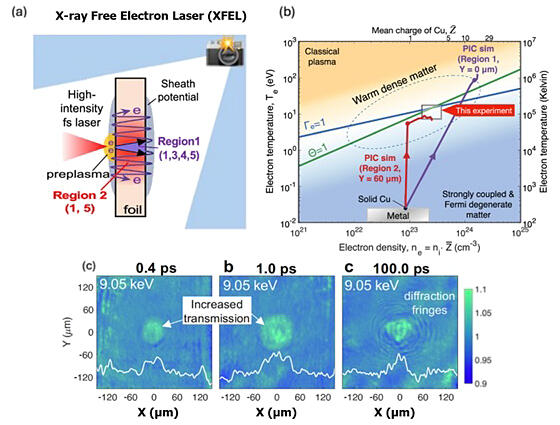An international research team led by Professor Yasuhiko Sentoku of the Institute of Laser Engineering at Osaka University and Associate Professor Hiroshi Sawada of the University of Nevada, Reno, along with Japan Synchrotron Radiation Research Institute (JASRI), RIKEN SPring-8 Center, SLAC National Accelerator Laboratory, the University of Alberta, Lawrence Livermore National Laboratory, and the University of Rochester has successfully captured the transition of a solid copper thin film into plasma inside the thin film. This transition was captured when the thin film was heated with a high-intensity laser beam using high-speed imaging by the X-ray free-electron laser (XFEL) SACLA. The results were published in Nature Communications.

Provided by Osaka University
Since the heating time of intense laser pulses is about one hundred trillionth of a second and the dynamics of fast electrons produced by the heating process dominate the development of the plasma state, no method existed yet to capture this moment. The research group developed a spatiotemporally resolved measurement method using the SACLA XFEL and succeeded in capturing the development of the plasma state in the heated copper thin film for the first time in the world.
The physics of heating high-density plasma using fast electrons is an important finding in the view of high-efficiency nuclear fusion (which requires fast ignition methods), an indispensable aspect required for the realization of laser nuclear fusion being studied at the Institute of Laser Engineering. The experiment also revealed that in the process of instantly changing the copper thin film into plasma, it changes into an intermediate state between plasma and the metal, called the state of solid-to-plasma transition. The information on the physical properties of this state is necessary to understand the state of planetary interiors and fuel spheres in laser fusion.
Sentoku said, "The process in which a strong laser beam heats a substance to form plasma occurs instantaneously in a short time of just one hundred trillionth of a second. Only numerical simulations have been able to show the details of the heating process until now. Now, using a new eye called the XFEL, we have succeeded in capturing the process of matter transitioning into plasma in an extremely short period of time for the first time. As a theoretical researcher, I am pleased that the results of XFEL measurements are in good agreement with our predictions. Further, we also made some discoveries that differed from our predictions, which we believe will lead to a deeper understanding in the future."
Journal Information
Publication: Nature Communications
Title: Spatiotemporal dynamics of fast electron heating in solid-density matter via XFEL
DOI: 10.1038/s41467-024-51084-4
This article has been translated by JST with permission from The Science News Ltd. (https://sci-news.co.jp/). Unauthorized reproduction of the article and photographs is prohibited.




